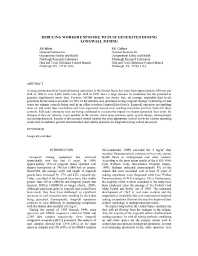Mining Publication: Reducing Worker Exposure To Dust Generated During Longwall Mining
Original creation date: January 2001
Average production from longwall mining operations in the United States has risen from approximately 800 tons per shift in 1980 to over 4,600 metric tons per shift in 1999. Such a large increase in production has the potential to generate significantly more dust. Previous NIOSH research has shown that, on average, respirable dust levels generated by the shearer accounts for 50% of the airborne dust generated during longwall mining. Ventilating air and water are primary controls being used in an effort to reduce longwall dust levels. Longwall operators are applying more air and water than ever before and have expressed concern over reaching maximum practical limits for these controls. Full-scale laboratory tests are being conducted to evaluate the impact on shearer-generated dust levels for changes in face air velocity, water quantity at the shearer, water spray pressure, spray system design, mining height and cutting direction. Results of this research should identify the most appropriate control levels for various operating conditions. In addition, general recommended dust control practices for longwall mining will be discussed.
Authors: JP Rider, JF Colinet
Conference Paper - January 2001
NIOSHTIC2 Number: 20021421
Proceedings of the Seventh International Mine Ventilation Congress, 2001, Krakow, Poland, 2001 Jan; :275-282
See Also
- Benchmarking Longwall Dust Control Technology and Practices
- Best Practices for Controlling Respirable Dust in Coal Mines
- Controlling Dust Exposures in Longwall Mining Utilizing A Simple Barrier
- Dust Underfoot: Enclosed Cab Floor Heaters Can Significantly Increase Operator's Respirable Dust Exposure
- Evaluation of the Approach to Respirable Quartz Exposure Control in U.S. Coal Mines
- Improved Drill Shroud Capture of Respirable Dust Utilizing Air Nozzles Underneath the Drill Deck
- Improved Dust Control Methods for Longwall Mining
- Improving Silica Dust Control Through Targeted Research
- Laboratory Testing To Quantify Dust Entrainment During Shield Advance
- Status of Dust Control Technology on U.S. Longwalls
- Page last reviewed: 9/21/2012
- Page last updated: 9/21/2012
- Content source: National Institute for Occupational Safety and Health, Mining Program


 ShareCompartir
ShareCompartir
